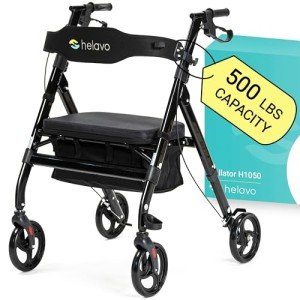Easy-To-Use Walker Tools To Make Your Daily Life Easy-To-Use Walker Tr…
페이지 정보

본문

The Ultimate Guide to Easy-To-Use Walkers: Empowering Mobility for All
Mobility is an essential aspect of everyday living, and for numerous individuals, especially the elderly and those with mobility obstacles, walkers can substantially boost independence and safety. An easy-to-use walker can be the distinction between depending on assistance and gaining back autonomy. This blog post intends to explore numerous types of walkers, their features, and how individuals can pick the right walker according to their needs.

Understanding Walkers: Types and Features
Walkers are available in several styles tailored to particular needs, levels of mobility, and individual choices. The following table summarizes the most typical types of walkers, their features, and potential benefits.
| Walker Type | Description | Benefits |
|---|---|---|
| Requirement Walker | A lightweight, basic frame with four legs. | Offers stability and support; easy to maneuver. |
| Two-Wheeled Walker | Features two wheels at the front for easy mobility. | Provides support while enabling for smoother motion. |
| Four-Wheeled Walker | Also known as a rollator, it has four wheels. | Permits for higher mobility and consists of a seat for resting. |
| Knee Walker | Created for individuals with foot or ankle injuries. | Enables users to rest weight on the knee while moving with the other leg. |
| Chair Walker | Combines a walker with a seat and storage. | Offers benefit for longer ranges; terrific for resting. |
| Foldable Rollator Walker Walker | Can be folded for easy transport and storage. | Portability makes it perfect for travel. |
Aspects to Consider When Choosing a Walker
Choosing the ideal walker is vital for making sure safety and convenience. Below are key factors to consider:
Mobility Level: Assess the user's current mobility and balance. Those who require optimum stability might take advantage of a standard walker, while more mobile users might choose a Safe Rollator Walker.
Weight Capacity: Walkers are designed with particular weight limitations. Always inspect the manufacturer's standards to guarantee safety.
Height Adjustment: An appropriately fitted walker is necessary for convenience. Search for adjustable height choices to ensure it suits the user's stature.
Surface Type: Consider where the walker will primarily be utilized. Some walkers are much better fit for outdoor usage, while others may work best on carpets or indoors.
Storage Needs: If the user typically carries personal products, walkers with baskets or trays might be beneficial.
Additional Features to Look For
Walkers have developed to consist of various features targeted at improving user experience. Some noteworthy features consist of:
Hand Grips: Ergonomically developed hand grips add to comfort and control.
Brakes: For rollators, check for reliable brakes which offer added security when decreasing or stopping.
Weight: Lightweight materials enhance maneuverability and ease of transport.
Seat and Backrest: For users who might need to rest, choices with seats and back-rests provide much-needed support.
Devices: Consider additional items like trays, baskets, or lights that can improve walker performance.
The Benefits of Using a Walker
Choosing an easy-to-use walker can bring numerous advantages for users and caretakers alike:
Increased Independence: Walkers minimize reliance on others, empowering users in their everyday regimens.
Improved Safety: They offer important support and balance, lowering the danger of falls and associated injuries.
Boosted Mobility: Walkers enable individuals to maintain Mobility Aid even with minimal physical abilities.
Activity Encouragement: Using a walker can inspire users to participate in routine motion, promoting overall health.
Social Interaction: Increased mobility motivates users to participate in social activities, improving emotional wellness.
FAQs about Walkers
1. How do I know which walker is ideal for me?
Selecting the right walker involves examining your mobility needs, weight capacity, and personal preferences. Consulting with a healthcare specialist can also offer valuable insights.
2. Are walkers covered by insurance?
Many insurance strategies, including Medicare, will cover walkers if they are deemed clinically required. It's best to check with your strategy for particular coverage information.
3. How can I preserve my walker?
Regular maintenance consists of examining wheels and brakes for damage, cleaning up the frame, and checking rubber suggestions for wear.
4. Can I use a walker outdoors?
Yes, there are specific walkers developed for outdoor usage, such as four-wheeled rollators, which use greater stability on different surface areas.
5. What is the typical weight limit for walkers?
Weight limitations can differ commonly depending upon the model and producer. The majority of standard walkers support approximately 300 pounds, however it's necessary to check specific specs.
Conclusion: Choosing the Right Walker for Enhanced Mobility
An easy-to-use walker is more than simply a tool; it represents independence and self-respect for numerous users. Whether it's a lightweight basic walker, a feature-rich rollator, or a specialized knee walker, the options are large and varied. By comprehending the different kinds of walkers available, considering essential features, and recognizing the substantial benefits they provide, people can make educated decisions that line up with their needs.
Remember, while this guide functions as a foundational resource, it is always suggested to seek advice from a healthcare expert for tailored suggestions. By selecting the best walker, individuals can actively engage in life, maintain their mobility, and pursue their enthusiasms without limit.
- 이전글12 Stats About Milton Keynes Auto Locksmiths To Make You Think About The Other People 25.10.05
- 다음글10 Best Facebook Pages Of All Time Concerning Buy A Genuine German Driver's License 25.10.05
댓글목록
등록된 댓글이 없습니다.
